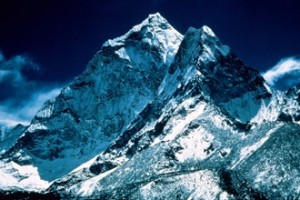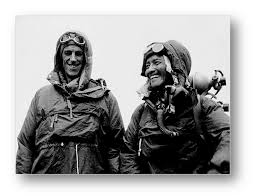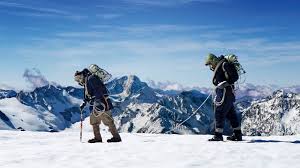 Beyond the Edge is a triumphant New Zealand-made documentary telling the story of the conquest of Everest in 1953 by Kiwi hero Edmund Hillary and experienced Nepalese sherpa Tenzing Norgay.
Beyond the Edge is a triumphant New Zealand-made documentary telling the story of the conquest of Everest in 1953 by Kiwi hero Edmund Hillary and experienced Nepalese sherpa Tenzing Norgay.
Many films have been made about climbing Everest, particularly the dramatic first conquest of the mountain, but none are quite like this.
The extensive footage shot by the expedition as they crawled up the mountain has been used many times and impressive reconstructions have been created, but never before have both been rendered in spectacular 3D.
A 3-dimensional film about mountaineering sounds like a treat, but the effectiveness of the new technology has been extremely varied since Avatar became the first high-profile immersive experience.
Will the audience be clinging onto their chairs screaming as 29,000ft of sky appears between them and the sharp ground? Or will they find themselves wondering why they’re wearing 2 pairs of glasses halfway through?
Since Avatar there have been some shameless examples of films piggybacking on the new fad to add pounds onto ticket prices and not fully utilising the technology.
Texas Chainsaw Massacre 3D and Clash of the Titans were poor films to start off with but the haphazard 3D effects that were thrown in added nothing.
3D has been used skilfully for more artistic reasons than increasing revenue. Werner Herzog’s 2011 doc Cave of Forgotten Dreams used 3D techniques to accentuate depth and shadow after he was granted permission to film 32,000 year old cave art in France.
A 3D documentary about mountaineering sounds like a great idea on paper. Aerial shots of rocky crags jutting out at the audience, snow falling out of the screen, rope lassoing round the theatre – I was expecting an entertaining Imax film with a bit more of a backstory.
Beyond the Edge managed to be a lot more than that. I wasn’t paralysed with vertigo but the 3D managed to explain the terrain of the mountain in a way I had never seen before.
The problem with Everest docs before – although succeeding in conveying the epic achievement, the hardship, the dangers of the climb – was that the route up the mountain was very hard to grasp in the mind’s eye. Shots of the long and arduous ascent up the icefall, then the cwm, up to the col and finally to the peak varied little from the surrounding mountain landscape and a sense of the scale of each section was hard to grasp.
This film succeeded in zooming in over the broad rises and sudden falls of the terrain until it gave a very clear and detailed impression of the ground the expedition was covering and the kind of inclines they were climbing. The 3D element was key to this and gave a depth to the wide shots that would have been lost in a 2 dimensional film.
I spoke to the director, Leanne Pooley, who explained that the decision to shoot it in 3D was made in the first meeting:
“We wanted to send people on a journey to the top and make the film an experience,” she said. “After all we all know how the story ends.”
“Hopefully it also gave more a sense of scale. My favourite shot is of their tiny tent flapping in the wind on the edge during their final ascent.”
The 3D was also used to delve into Edmund Hillary’s psyche in a very enjoyable way.
When the story of Hillary’s bee-keeper background was being told towards the beginning of the film the audience began to hear a faint buzzing all around them. Suddenly there were bees everywhere!
Very convincing 3D holographic bees were flying around the theatre.
I don’t know how disproportionately I enjoyed this part but it was the first thing I mentioned to people afterwards. I was beaming once more when they re-appeared towards the end of the film.
Hillary and Tenzing stagger up the final ascent after climbing the sheer 40ft shelf now known as Hillary’s Step. Exhausted and low on oxygen their voices describe their mind playing tricks on them and dreamy hallucinations cause them to briefly forget where they are. The film depicts this madness with a Hillary-eye-view as he staggers up the mountain, 3D bees flying through the air as if he was back in Auckland.
The pride that New Zealanders feel about Edmund Hillary – a modest, honest, hard-working Kiwi bee-keeper – is at the core of the film and he shines from the centre of the action as a warming beacon of sturdy reliability.
From the very start you see Hilary’s face – his real face in the old footage and the actor’s in the reconstructions are almost indistinguishable – and the film tracks his upbringing as a farmer’s son and bee-keeper in New Zealand.
“There was a national call-out throughout New Zealand to find an actor to play him. We were looking for Ed.” explained Leanne. “I did a little raindance after I saw him come in the room, the resemblance was uncanny.”
“Ed is a god in New Zealand so there was a lot of excitement. We had all shapes and sizes turning up. Some were four foot eight!”
“Chad didn’t only look like Ed but he had his manner – a bit awkward, a bit shy. He embodied the same characteristics.”
The many voices describing the action were skilfully woven in and director Leanne Pooley’s decision not to use talking heads and have the voices float disembodied over fantastic shots of the mountain was a masterstroke. “We didn’t want to cut to a dark room and take people off the mountain,” said Leanne.
Some amazing and very insightful words are said by characters such as Tenzing, George Lowe (the other Kiwi on the expedition), John Hunt (the expedition leader) and other experts including Hillary himself, interviewed before he died in 2008.
Hillary’s real voice is very prominent throughout and he can almost be described as the narrator of the film. Some snippets are incredibly frank about the sheer terror and humbling might of the mountain and add to the atmosphere nicely.
The climax of the film is a good study in suspense and it is easy to forget that they survived alive and well after their successful climb. Leanne explained that Peter Hillary, Edmund’s son, told her that by the end even he wasn’t sure they made it! In the director’s words: “It’s a slow burner, a slow tightening of the screw.”
Beyond the Edge has completed a triumphant run in New Zealand, becoming the most successful documentary ever in that part of the world and was given rave reviews at its premiere in Toronto in September. It is released in the UK on Friday 23rd May in cinemas nationwide.




